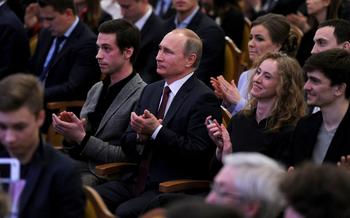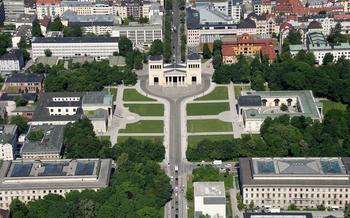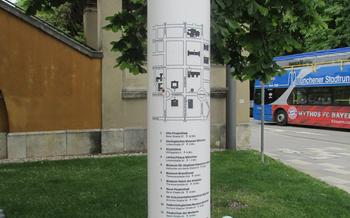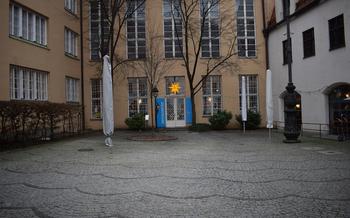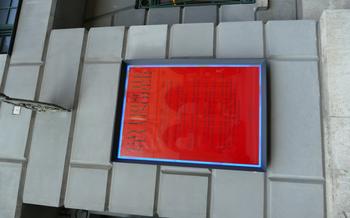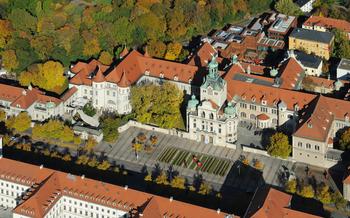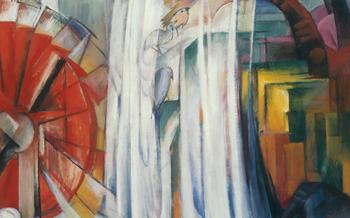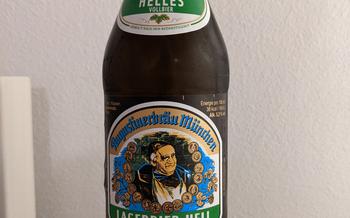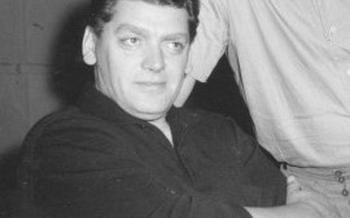
Gasteig Cultural Centre
- Historical Significance
- Theatres and Concert Halls: A Haven for Performing Arts
- Munich Philharmonic Orchestra
- Other Cultural Institutions
- Gasteig Library: A Haven for Bibliophiles
- Public Art
- Gasteig HP8: A Creative Powerhouse
- Gasteig Events:
- Food and Drink: Culinary Delights at the Gasteig
- Accessibility
- Getting There
- History of the Gasteig
- Impact on the Local Community
- Insider Tip
Historical Significance
The Gasteig Cultural Centre stands as a testament to Munich's rich cultural heritage and architectural prowess. Its journey began in the 1950s when the city envisioned a vibrant cultural hub that would cater to the growing demand for arts and education. The foundation stone was laid in 1985, and after years of meticulous planning and construction, the Gasteig opened its doors to the public in 198
The architectural style of the Gasteig is a striking blend of modernism and classicism. The building's exterior, adorned with glass and concrete, reflects the modernist aesthetic that was prevalent in the 1980s. However, the interior spaces, with their warm colors and elegant design, evoke a sense of timeless sophistication. The Gasteig has become an iconic landmark in Munich, representing the city's commitment to fostering culture and creativity.
Throughout its history, the Gasteig has played host to countless significant events and cultural milestones. It has welcomed renowned artists, musicians, and performers from around the world, who have graced its stages with unforgettable performances. The Gasteig has also been the venue for prestigious conferences, exhibitions, and festivals, attracting visitors from far and wide.
Theatres and Concert Halls: A Haven for Performing Arts
Within the walls of the Gasteig Cultural Centre lies a treasure trove of performance venues that cater to a diverse range of artistic expressions. The Philharmonie, the crown jewel of the Gasteig, is an architectural masterpiece renowned for its exceptional acoustics. This grand auditorium hosts world-renowned orchestras, such as the Munich Philharmonic, and captivates audiences with its awe-inspiring performances of classical music.
The Carl Orff Hall, named after the renowned German composer, offers a more intimate setting for chamber music concerts, recitals, and contemporary music performances. Its versatile stage and state-of-the-art sound system create an immersive experience for both performers and listeners alike.
The Black Box, a flexible and experimental space, pushes the boundaries of artistic expression. This adaptable venue hosts avant-garde theatre productions, dance performances, and multimedia events that challenge conventions and ignite creativity.
Over the years, the Gasteig's stages have graced by a constellation of legendary artists, including conductors like Leonard Bernstein and Herbert von Karajan, pianists such as Vladimir Horowitz and Martha Argerich, and acclaimed singers like Maria Callas and Plácido Domingo. These performances have left an indelible mark on the cultural history of Munich and continue to inspire generations of music lovers.
Munich Philharmonic Orchestra
The Gasteig Cultural Centre is home to one of Germany's most renowned orchestras, the Munich Philharmonic Orchestra. Founded in 1893, the orchestra has a long and illustrious history, having performed with some of the world's greatest conductors and soloists.
Under the baton of its current music director, Valery Gergiev, the orchestra has achieved international acclaim for its interpretations of both classical and contemporary repertoire. The orchestra is particularly renowned for its performances of the works of Richard Strauss and Gustav Mahler, and has released numerous award-winning recordings of their music.
The Munich Philharmonic Orchestra performs regularly at the Gasteig, offering a diverse range of concerts throughout the season. Visitors to Munich can experience the orchestra's virtuosity and passion for music in the stunning acoustics of the Philharmonie, one of the Gasteig's most prestigious concert halls.
In addition to its concert schedule, the Munich Philharmonic Orchestra is also involved in a number of educational and outreach programs, including concerts for young people and masterclasses for aspiring musicians. The orchestra is committed to fostering the next generation of musical talent and ensuring that classical music remains accessible to all.
Other Cultural Institutions
In addition to the theatres and concert halls, the Gasteig is also home to several other cultural institutions. The International Youth Library, founded in 1949, is a unique collection of children's books from all over the world. With over 600,000 volumes in over 100 languages, it is a treasure trove for young readers and researchers alike. The library hosts regular events and exhibitions, including storytelling sessions, author readings, and workshops.
The Munich Volkshochschule, or Adult Education Center, is another important institution located within the Gasteig. Founded in 1919, the VHS offers a wide range of courses and workshops for adults of all ages and interests. From language classes and computer courses to art classes and cooking classes, there is something for everyone at the VHS. The VHS also hosts regular lectures, discussions, and film screenings on a variety of topics.
The Gasteig's cultural offerings are not limited to these three institutions. The complex also houses the Munich Documentation Center for Contemporary Art, the Institute for Theater Studies, and the Bavarian State Orchestra. With so much to see and do, the Gasteig is a must-visit for anyone interested in experiencing Munich's vibrant cultural scene.
Gasteig Library: A Haven for Bibliophiles
Within the vibrant Gasteig complex, bookworms and literature enthusiasts will find solace and inspiration at the Gasteig Library. Renowned as one of the largest public libraries in Munich, the Gasteig Library boasts an impressive collection of over 600,000 books, periodicals, and multimedia resources. Whether you seek knowledge, solace, or simply a quiet space to delve into your favorite stories, the Gasteig Library has something for every bibliophile.
The library's diverse collection spans a wide range of subjects, including literature, history, philosophy, and the arts. Visitors can peruse the shelves for classic works, contemporary bestsellers, and obscure gems that may spark their curiosity. In addition to its extensive book collection, the library also offers a variety of digital resources, including e-books, audiobooks, and databases, catering to the needs of tech-savvy readers.
Beyond its impressive collection, the Gasteig Library also offers a welcoming and conducive environment for learning and exploration. The library's spacious reading rooms, equipped with comfortable seating and ample natural light, invite visitors to settle in and get lost in their chosen literature. The library also hosts regular events and programs, such as book readings, author talks, and workshops, providing opportunities for readers to engage with writers, fellow bookworms, and the broader literary community.
Public Art
The Gasteig is home to a diverse collection of public art installations and sculptures, which add to the cultural ambiance of the complex. These artworks range from traditional sculptures to contemporary installations, and they reflect the diverse artistic styles and perspectives that have shaped Munich's cultural landscape.
One of the most notable public art pieces at the Gasteig is the "Kugelspielerin" (Sphere Player) sculpture by German artist Olaf Metzel. This sculpture, located in the courtyard of the Gasteig, features a bronze figure of a young woman playing with a sphere. The sculpture's dynamic form and playful nature create a sense of movement and energy, inviting viewers to engage with the artwork and contemplate its deeper meanings.
Another significant public art installation at the Gasteig is the "Lichtwand" (Light Wall) by American artist James Turrell. This installation, located in the foyer of the Philharmonie, consists of a large wall of colored light panels that change color and intensity over time. The "Lichtwand" creates a mesmerizing and immersive experience for viewers, inviting them to contemplate the nature of light and perception.
These are just a few examples of the many public art installations and sculptures that can be found at the Gasteig. Visitors are encouraged to take some time to explore the complex and discover these hidden gems, which offer a unique and enriching perspective on Munich's vibrant art scene.
Gasteig HP8: A Creative Powerhouse
Within the Gasteig complex, a former power plant has been given a new lease on life as the Gasteig HP8, a vibrant creative space that adds an industrial edge to the cultural center. The HP8 has been transformed into a hub for innovation and experimentation, hosting a diverse range of events and exhibitions that push the boundaries of art and culture.
The raw, industrial aesthetic of the HP8 provides a unique backdrop for concerts, workshops, and art installations. The space has become a haven for emerging artists and creatives, who are drawn to its open and collaborative atmosphere. Visitors to the HP8 can expect to experience cutting-edge performances, thought-provoking exhibitions, and immersive installations that challenge traditional notions of art and creativity.
One of the highlights of the HP8 is the annual "HP8 Art Festival," which brings together a collective of local and international artists to showcase their works in a variety of mediums. The festival features interactive installations, live performances, and workshops, inviting visitors to engage with the creative process and explore the boundaries of contemporary art.
The Gasteig HP8 is a testament to the Gasteig's commitment to fostering creativity and innovation. It represents a fusion of the past and the present, where the industrial heritage of the power plant meets the vibrant energy of the cultural center. Whether you're an art enthusiast, a music lover, or simply looking for a unique and inspiring space, the Gasteig HP8 is a must-visit destination in Munich.
Gasteig Events:
The Gasteig is a vibrant hub for cultural events in Munich, offering a diverse range of performances and exhibitions throughout the year. From classical concerts to contemporary theatre, there is something to suit every taste and preference.
The Gasteig Philharmonie is the main concert hall of the Gasteig, hosting world-renowned orchestras and soloists. The acoustics of the hall are renowned for their clarity and warmth, making it a popular choice for classical music performances.
The Carl Orff Hall is a smaller venue that is often used for chamber music concerts, recitals, and jazz performances. It is named after the composer Carl Orff, who was a professor at the Munich Academy of Music.
The Black Box is a flexible performance space that can be used for a variety of events, including theatre productions, dance performances, and film screenings. It is a popular venue for experimental and avant-garde performances.
In addition to concerts and performances, the Gasteig also hosts a variety of exhibitions, workshops, and lectures. The Gasteig Library regularly hosts author readings and book signings, while the International Youth Library hosts exhibitions and events related to children's literature.
To find out about upcoming events at the Gasteig, visitors can check the Gasteig website or pick up a copy of the Gasteig magazine, which is available at the Gasteig information desk. Tickets for events can be purchased online or at the Gasteig box office.
Food and Drink: Culinary Delights at the Gasteig
The Gasteig Cultural Centre offers a diverse range of dining options to cater to the needs of visitors and locals alike. Whether you're looking for a quick bite to eat between events or a leisurely meal to savor the cultural atmosphere, you'll find something to your taste at the Gasteig.
The Gasteig Restaurant is a popular choice for those seeking a fine dining experience. Offering a seasonal menu featuring contemporary Bavarian cuisine with a modern twist, the restaurant is known for its high-quality ingredients and innovative dishes. The Gasteig Café is a more casual option, serving a variety of light meals, snacks, and beverages throughout the day. From freshly baked pastries to hearty sandwiches and refreshing salads, the café provides a welcoming space to relax and refuel.
For those seeking a unique culinary experience, the Gasteig HP8 offers a variety of dining options within its former power plant setting. The HP8 Restaurant serves modern European cuisine in a stylish and industrial atmosphere, while the HP8 Café offers a more relaxed setting with a menu of light bites and drinks. The HP8 Bar is a popular spot for after-work drinks and socializing, with a wide selection of cocktails, beers, and wines to choose from.
No matter your preference, you're sure to find something to satisfy your appetite at the Gasteig Cultural Centre. So, take a break from exploring the cultural offerings and indulge in a culinary delight or two to enhance your Gasteig experience.
Accessibility
The Gasteig Cultural Centre is committed to accessibility for all visitors, regardless of their physical abilities or disabilities. The building is fully equipped with wheelchair ramps, elevators, and accessible restrooms, ensuring that everyone can navigate the spaces with ease. Additionally, the Gasteig offers a range of special services and programs for visitors with disabilities. These include:
-
Audio description and sign language interpretation: For select performances and events, audio description and sign language interpretation are available to enhance the experience for visually and hearing-impaired visitors.
-
Wheelchair-accessible seating: Wheelchair-accessible seating is available in all theatres and concert halls, ensuring that visitors can enjoy performances from the best possible vantage point.
-
Accessible tours: The Gasteig offers guided tours that are tailored to the needs of visitors with disabilities. These tours provide in-depth information about the Gasteig's history, architecture, and cultural offerings.
-
Trained staff: The Gasteig staff is trained to assist visitors with disabilities and ensure that they have a positive and enjoyable experience. If you have any specific needs or questions, please do not hesitate to ask a member of staff for assistance.
While the Gasteig is generally accessible, there may be some challenges or barriers that visitors with disabilities may encounter. For example, some of the older buildings within the complex may not have fully accessible features, and there may be occasional construction or maintenance work that can impact accessibility. However, the Gasteig is continuously working to improve accessibility and remove any obstacles that may hinder visitors with disabilities from fully enjoying the cultural offerings of the centre.
Getting There
- Public Transportation: The Gasteig is conveniently located near several public transportation options. The closest U-Bahn (subway) stop is "Gasteig," which is served by the U5 line. Several bus lines also stop nearby, including the 54, 58, and 15
- Parking: There are several parking garages located near the Gasteig. The closest one is the "Parkhaus Gasteig," which is located directly underneath the cultural center. Other nearby parking options include the "Parkhaus Isartor" and the "Parkhaus am Deutschen Museum."
- Tips: To avoid crowds and traffic, it is best to visit the Gasteig during off-peak hours, such as early in the morning or late in the evening. If you are driving, be aware that parking can be limited, especially during events. Consider using public transportation or carpooling to reduce your impact on the environment.
History of the Gasteig
The Gasteig Cultural Centre has a rich and storied history, dating back to its origins as a monastery in the 15th century. The Augustinian monks who founded the monastery played a crucial role in the development of the surrounding area, establishing a school and a library that would later form the foundation for the Gasteig's cultural offerings.
In the 19th century, the monastery was secularized and its buildings were used for various purposes, including a hospital and a military barracks. However, the site's cultural significance was never forgotten, and in the early 20th century, plans began to emerge for the creation of a new cultural center on the site.
The Gasteig as we know it today was built in the 1950s and 1960s, a time of great cultural renewal in Munich. The complex was designed by renowned architect Werner Egk, who sought to create a space that would be both modern and inviting, reflecting the spirit of the new era.
Over the years, the Gasteig has undergone several renovations and expansions, each reflecting the changing needs and tastes of the city's cultural scene. In the 1980s, a new concert hall, the Philharmonie, was added to the complex, and in the 1990s, the Gasteig HP8, a former power plant, was transformed into a creative space for exhibitions and events.
Today, the Gasteig stands as a testament to Munich's rich cultural heritage, a vibrant hub where history and modernity converge, offering a diverse range of cultural experiences to visitors from around the world.
Impact on the Local Community
The Gasteig Cultural Centre has had a profound impact on the local community and cultural scene in Munich. As a vibrant hub for arts, culture, and education, the Gasteig has played a crucial role in fostering creativity, promoting cultural exchange, and enriching the lives of countless individuals.
One of the most significant ways in which the Gasteig has impacted the local community is through its diverse range of educational programs and initiatives. The centre offers a variety of classes, workshops, and seminars on a wide range of topics, including music, dance, theatre, literature, and languages. These programs provide opportunities for people of all ages and backgrounds to learn new skills, explore their interests, and connect with like-minded individuals.
The Gasteig is also a strong supporter of local artists and cultural organizations. The centre regularly hosts exhibitions, performances, and events showcasing the work of emerging and established artists from the Munich area. This provides a platform for local talent to gain exposure, build connections, and contribute to the city's cultural vibrancy.
In addition, the Gasteig is committed to promoting cultural accessibility and inclusivity. The centre offers a range of programs and services designed to make its facilities and events accessible to people with disabilities. The Gasteig also works closely with community organizations to provide opportunities for underserved populations to engage with the arts and culture.
Through its vielfältig educational programs, support for local artists, and commitment to accessibility, the Gasteig Cultural Centre has become an integral part of the Munich community. The centre's contributions to the city's cultural landscape are immense, and it continues to play a vital role in shaping the city's identity as a vibrant and dynamic cultural hub.
Insider Tip
-
Secret spot: Venture to the rooftop terrace of the Gasteig for panoramic views of Munich's skyline. This hidden gem offers a serene escape from the bustling city below.
-
Must-see event: Don't miss the annual "Lange Nacht der Musik" (Long Night of Music), where the Gasteig stays open late and offers a marathon of concerts, performances, and exhibitions.
-
Money-saving tip: Take advantage of the Gasteig's "Kulturpass" (Culture Pass), which offers discounted tickets to various events and exhibitions throughout the year.
